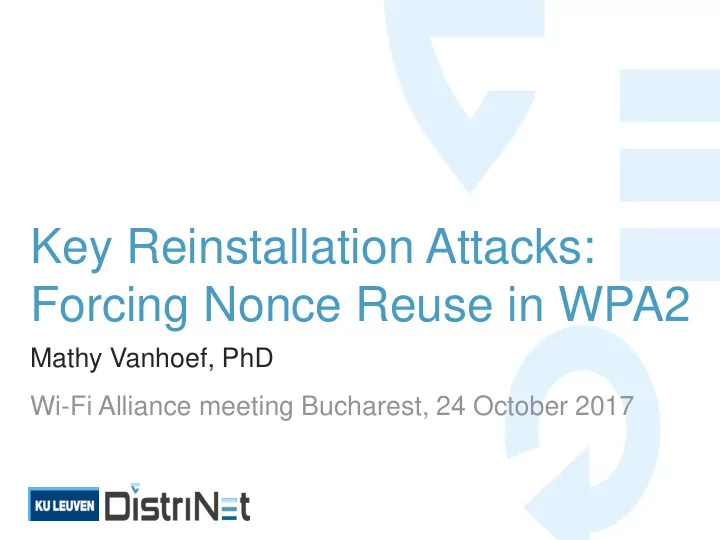

Key Reinstallation Attacks: Forcing Nonce Reuse in WPA2 Mathy Vanhoef, PhD Wi-Fi Alliance meeting Bucharest, 24 October 2017
Overview 1. Key reinstallation in 4-way handshake 2. Misconceptions and remarks 3. Steps to improve Wi-Fi security?
The 4-way handshake Two main purposes: › Mutual authentication › Negotiate fresh PTK: pairwise temporal key Appeared to be secure: › No attacks in more than a decade › Proven as secure in 2005 1 › That is: negotiated key (PTK) is secret
Wi-Fi handshake (simplified) PTK = Combine(shared secret, ANonce, SNonce) 4
Wi-Fi handshake (simplified) A ttack isn’t about ANonce or SNonce reuse PTK = Combine(shared secret, ANonce, SNonce) 5
Wi-Fi handshake (simplified) 6
Wi-Fi handshake (simplified) PTK is installed 7
Wi-Fi handshake (simplified) 8
Encrypting data frames (simplified) Nonce Plaintext data = Packet Number Nonce Keystream should never be reused Each nonce results in a unique keystream 9
Wi-Fi handshake (simplified) Installing PTK resets nonce to zero 10
Key Reinstallation Attack 11
12
Block Msg4 13
14
In practice Msg4 is sent encrypted 15
16
Key reinstallation! nonce is reset 17
18
Same nonce is used! 19
keystream 20
keystream Decrypted! 21
Overview 1. Key reinstallation in 4-way handshake 2. Misconceptions and remarks 3. Steps to improve Wi-Fi security?
Misconceptions I No useful data is transmitted after handshake › Trigger handshakes during TCP connection Difficult to derive keystream › Already have 82 bytes from encrypted Msg4 Need high signal strength to get MitM › Use channel switch announcements, BSS Transition Requests, jammers, …
Misconceptions II Need to be close to network › Can use special antenna 2,3 Using (AES-)CCMP mitigates the attack › No, still allows decryption & replay of frames Enterprise networks (802.1x) are not vulnerable › Also use 4-way handshake and are affected
Misconceptions III You need the password to perform attacks › Nope. Then you could decrypt all already … Updating only client or AP is sufficient › Both vulnerable clients and vulnerable APs need to apply patches Attack complexity is hard › Script only needs to be written once
“ Attacks only get better, they never get worse. ” — Bruce Schneier
Overview 1. Key reinstallation in 4-way handshake 2. Misconceptions and remarks 3. Steps to improve Wi-Fi security?
Countermeasures Problem: many clients will not get updated Solution: AP can prevent attacks on clients! › Don’t retransmit message 3/4 › Don’t retransmit group message 1/2 However: › Impact on reliability currently unclear › Clients still vulnerable when connected to other unmodified APs 28
Fuzzing Basic fuzzing as part of device certification › Test against key reinstallations › Fuzzing length fields: avoid well-known bugs › Plaintext frames rejected if encryption enabled? › … Advanced fuzzing of widely used tools: › Can do more costly fuzzing on specific tools › Make these fuzzing tools open source
“ Millions of dollars saved (for Microsoft and the world). ” Patrice Godefroid, Microsoft Research
Other recommendations Not Wi- Fi Alliance task, but … › Make standards easier to access. Just a download link, nothing on top. › Anyone should be able to easily follow discussions. Mailing list?
Need open source firmware Code is getting more closed: › Functionality is offloaded to closed firmware › E.g. 4-way handshake is being offloaded › We cannot trust this code! At least open source security critical parts? › Catch problems earlier & get help
Long-term: formal verification Programming is hard. Are patches correct? › Missed attack against wpa_supplicant 2.6 Collaboration with academia: › Create formal and precise state machines › Formal verification of core code › E.g. prove correctness of open source tools
Thank you! Questions? krackattacks.com
References 1. C. He, M. Sundararajan, A. Datta, A. Derek, and J. Mitchell. A Modular Correctness Proof of IEEE 802.11i and TLS. In CCS, 2005. 2. S. Antakis, M. van Cuijk, and J. Stemmer. Wardriving - Building A Yagi Pringles Antenna. 2008. 3. M. Parkinson. Designer Cantenna. 2012. Retrieved 23 October 2017 from https://www.mattparkinson.eu/designer- cantenna/ 3 5
Recommend
More recommend